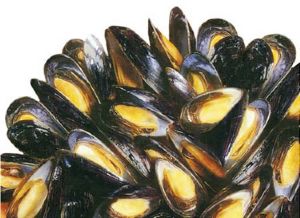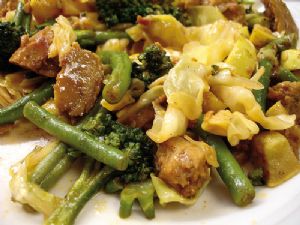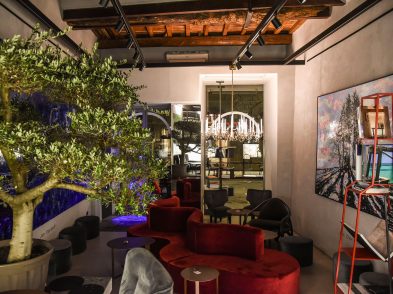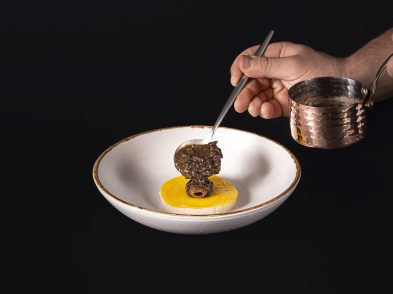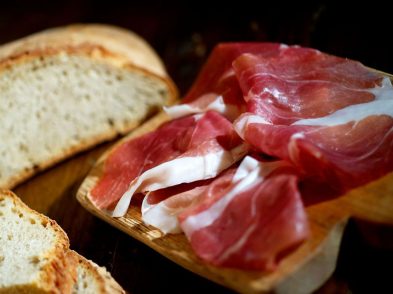Seems unusual,
but the act of preparing a simple pot of ragu can mean stepping onto a culinary
minefield, where any number of potential wrong moves await the terrified,
hapless cook. I’ve only found this out upon moving to Italy. You see, spaghetti
Bolognese is frequently voted as one of popular dishes in the UK, and as an
expat Brit myself, I’ve got fairly distinct ideas about what it should look and
taste like. However, describing or showing this version to someone from Bologna
has invariably led to a recoil of horror, even accompanied by the sign of the
cross.
A little bit
of research indicates that the traditional and generally accepted version of
Italian ragu is a lot less tomato-heavy than the more well-traveled version. A
recipe I was given by an Italian chef, based on a fifteenth-century method,
calls for a base of milk and only a hint of tomato puree. However, it seems
that the shop-bought versions are quite tomato-heavy as well.
One dish,
various distinct versions, and each one seems to have the stamp of approval
from one quarter or another. But which is the best?
With this in
mind, a plan was hatched to stage a big event: the Great Florentine Ragu-Off
2008. Three dishes would be prepared: the fifteenth-century, Italian
chef-approved method; a shop-bought jar of ragu: and an international take on
the meal. These would then be presented to a select panel of judges who would
supply their thoughts and ratings.
First up: the
shop-bought ragu. For this, I purchased a jar of generic ragu from a
supermarket for less than one euro. It was a lot more tomato-ey than I expected
it to be-crushed tomatoes making up almost 50 percent of the total mass-and
contained pork and beef, as expected, along with some tantalizing-sounding
‘mixed herb flavours’ and, happily, not a lot in the way of artificial
ingredients and salt. To bulk it up a bit, I pimped it ever so slightly with
some more minced beef and a glass of red wine.
The judges were pretty impressed. The herb flavouring, in particular,
did well: one judge remarked that the ragu tasted ‘perfumed’ and that once the
aroma had gone, she immediately wanted another mouthful. The judges also
commented favourably on the smoothness and depth of flavour. Yikes.
With a couple of nagging doubts about the integrity of the panel, I
presented a sort of non-standard, handed-down British recipe: quite a lot of
tomato; fennel-flavoured sausage; minced beef; cubes of pancetta; stock; the
standard celery, onion and carrot mix; tomato puree; and wine. These are cooked
in varying quantities in a pan, with a couple of other bits and bobs thrown in
for good measure, then baked with a small amount of butter for a nice glossy
finish.
Fortunately, the judges liked this one as well. Although it came under
initial criticism for being a bit rich, the chunkiness of the meat and bits of
tomato (which, it has to be said, were due largely to my not being particularly
bothered about chopping them nice and fine) were also admired. The panel
noticed the blend of flavours, particularly from the juicy bits of sausage. I
realised at this point that the judges were OK and clearly could be trusted.
RAGU (Serves four)
300g minced
beef
150g pancetta,
in small cubes
150g
finocchiona sausage, pulled or chopped into very small pieces
1 red onion,
chopped very finely
1 carrot,
peeled and choppedvery finely
1 stick
celery, peeled and chopped very finely
30g tomato
puree
1 glass red
wine
1 ‘classico ‘stock
cube
1 tsp sugar
1 tbsp
balsamic vinegar
1 tin chopped
tomatoes
Salt, pepper
to taste
A small pat of
butter
Fry the pancetta and sausage in a pan until they start to release their
fat. Add the beef and stir very well, breaking all of the meat up as much as
possible, not allowing any chunks to form. Brown this all for 5 minutes or so.
Add the vegetables and sweat gently until soft. Stir in the tomato puree
and the wine. As soon as the alcohol has cooked from the wine, add the vinegar, sugar, stock
cube, and a little salt and pepper. When it starts to smell a little less
vinegary, add the tin of tomatoes, then simmer for 15-20 minutes or longer, until the
pieces of tomato are starting to dissolve. If it looks a bit dry while
simmering, you can add a bit of water.
Pour into an oven-proof dish and add the butter. Cover with foil or a
lid. Place in a pre-heated oven and cook at 160 degrees C for an hour. Stir
well, then serve. However, a
sobering moment arrived for all of us when the fifteenth-century Italian
version was presented. Now, I liked it a lot: best-quality minced steak cooked
gently and for a long time in milk, tomato puree, with a little beef stock,
seasoned well with the welcome addition of wine, slow-cooked vegetables, light
seasoning and finely chopped bacon. Following the recipe to the letter, I
produced a finished result that certainly looked and smelled like the ragu
you’d get in a restaurant in Bologna.
The judges
weren’t happy. Claiming that the dish was ‘too dry’ and ‘bland’, they voted
against this dish-without knowing that it was, in all respects, the real deal.
Now, there’s every possibility that I messed up somewhere along the line, and
perhaps they shouldn’t have battered their tastebuds with the very rich and
strongly-flavoured versions first. But
while the addition of milk to the dish certainly brings the subtle, dark taste
of the beef right to the front, this was not seen as a plus point by most. They
did unanimously agree that this ragu would taste far better in smaller
quantities, well mixed into lots of fresh pasta-as it should be served, in
fact.
The masses of
Italian gourmands are already, no doubt, readying their complaints, and with
this in mind, there are the following caveats. A jar of Italian ragu bought
from an Italian supermarket is of an understandably high quality and very
distinctively flavoured with the kind of things out of reach to an old-school
traditional cook. And the ‘variation on a theme’ ragu would have been
unachievable if I hadn’t been able to get top-notch Italian meat, vegetables
and other flavourings. Plus, modern
eating, in which we tend to heap nice-tasting stuff on our plate to the
detriment of any subtleties in flavouring, might put a simple, classic,
fifteenth-century dish at an automatic disadvantage.
But, the results came in, and elsewhere on this page you’ll find the
recipe for the winning dish. Happy shopping.
Ingreatnight: Chard
Tasty leaves, thick stem, and bright colours: what a delicious
vegetable. Most commonly, in the supermarkets, Swiss chard has dark green
leaves fringing a thick, white stem. But at this time of year it’s rapidly
going out of season and being replaced by its more gaudy cousins.
Chard can take pride of place in salad: eaten cold and young, like
spinach, shredded finely and dressed in something tangy. If it’s older and
bigger, you can cook it in a number of different ways. It’s great boiled in a
little stock, and then finished off with some butter, lemon juice and black
pepper. Or you can stir-fry it with a little chopped fresh ginger, some salt
and some aromatic oil.
The leaves and stems go particularly well in creamy, spicy dishes and
make a fine accompaniment for duck, in particular, as well as chicken or other
poultry. If chard has a big leaf and a tough stem, it’s going to taste bitter
if eaten raw: make sure that you cook it until it’s al dente, as this takes the
bitter flavor away.

